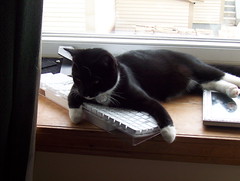My post last night was a bit cryptic, so let me walk through a bit more clearly what I’ve been doing, since I seem to have picked up the interest of some more people.
I currently am using Flickr to annotate my photos: primarily because I like their image region annotations, and partially because their API offers me a way to get lots of data out that I’ve put in, which is useful to me. So, that’s what I’m using for photo annotation at the moment, which may change at any point.
Masahide has a flickr2rdf service: flickr2rdf takes a Flickr Photo page URI and exports RDF from it: For example, a picture of myself, my ex girlfriend, and Foghorn Leghorn can be seen, fully annotated, using XSLT+RDF, via the flickr2rdf tool.
Additionally, the original photos stored at flickr (full size) have EXIF information: this information can be exported via Masahide’s equally cool exif2rdf tool: Foghorn Leghorn Example.
Once I have the photo_id of a photo, I can collect all these statements together. Additionally, since I am using tags from GeoBloggers for geolocation, I have a tool which parses out these tags (using the Flickr API) and creates Geo data for them.
I add a few tracking statements: specifically, links to seeAlso the final RDF/XSLT view of the image, (again, Foghorn Leghorn example). I serialize the Model out from Redland, and get a directory full of files full of RDF singletons. From here, I use cwm to process the singletons into an abbreviated RDF/XML file. These files are then synced to the http://crschmidt.net/albums/flickr/ directory. Here, I use a couple little tricks to add an XSLT declaration as the first line of each file, so that the content negotiated version offers XML delivered as application/xml, rather than just application/rdf+xml (which Firefox won’t display in a browser).
Next step is to add each of these files into an RDF model. Since I’m still occasionally changing statements, I’ve been dropping the whole model and readding every time: this doesn’t take too long, as it’s only a few hundred files, and Redland is speedy quick.
So, now we have a database full of RDF statements. Fine. But that’s not too useful. So, I have my SPARQL query interface. Which is all well and good, for people who have lots of knoweldge of RDF. It can provide some cool results.
But it doesn’t really do anything *fun*. So last night, I added an optional checkbox, that said “If you ahve something in a specific query format, process an XSLT file against it”. I tweaked this XSLT from masahide’s example, linked yesterday, into what it is now, which you can see, if you’re interested.
Well, that’s all well and good, but most people don’t understand SPARQL enough to know what they should type in. What’s the use of having to learn a language just to see some pictures? So, my next step was to add a search box specifically for Regions: my sparql page has a search box now specifically for this purpose.
I realized after a couple times, though, that using client side XSLT to process the XML was really slow, clunky, and generally ugly. Not to mention that Mozilla’s XSLT doesn’t let me disable-output-escaping on variables: so, I installed php4-xslt, and started using that implementation on the server side.
Yeah, that’s all well and good too, but now my pretty RDF with queries and all went away! So, I added them back: at the end of the Foghorn Search, in a comment, you’ll see:
Generated using the XSLT stylesheet at http://crschmidt.net/xslt/imgreg.xsl against the data generated by the query:
PREFIX dc: <http ://purl.org/dc/elements/1.1/>
PREFIX foaf: <http ://xmlns.com/foaf/0.1/>
PREFIX imgreg: <http ://www.w3.org/2004/02/image-regions#>
SELECT ?img,?title,?page,?desc,?atitle,?coord
WHERE {
?img
dc:title ?title;
foaf:page ?page;
dc:description ?desc;
imgreg:hasRegion ?r.
?r
dc:title ?atitle;
imgreg:coords ?coord.
FILTER REGEX(?atitle ,”Foghorn”) }
Data was:
followed by the XML version of the SPARQL query results.
Another interesting example: Schmidt – myself, family members, and others.
Anyway, being a bit more informative seemed appropriate given the situation. So there’s my implementation toy of the day.
